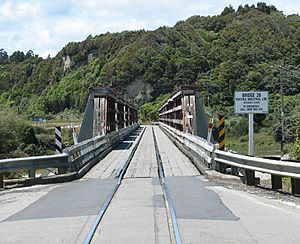Bridges in New Zealand facts for kids

New Zealand has many different kinds of bridges. These amazing structures help people and vehicles cross rivers, valleys, and other tricky spots. Most of New Zealand's bridges were built after European settlers arrived in the mid-1800s.
Contents
Road Bridges: Connecting Our Towns
Road bridges are super important for getting around New Zealand. They help cars, trucks, and buses travel safely across difficult areas. Here are some of the longest bridges on the main roads, called the State Highway network:
- Rakaia River bridge - This bridge is 1,757 metres long!
- Thorndon Overbridges - It measures 1,335 metres.
- Whirokino Trestle Bridge - This one is 1,098 metres long.
- Auckland Harbour Bridge - It stretches 1,020 metres across the water.
- Waitaki River Bridge - This bridge is 906 metres long.
- Hokitika River Bridge - It measures 740 metres.
- Haast River Bridge - This bridge is 737 metres long.
Single Lane Bridges: A Look Back in Time
Because New Zealand didn't always have a lot of traffic, many bridges were built with only one lane. This meant cars had to take turns crossing! While many of these have been replaced, some still exist on the main road network.
One famous single-lane bridge was the Kopu Bridge. It was 463 metres long and crossed the Waihou River. It was replaced in 2011 by a new, wider bridge with two lanes, making travel much easier.
Viaducts: Bridges Over Valleys
Viaducts are special types of bridges that are often built over valleys or deep gaps. They help roads or railways stay level across uneven land. Some well-known viaducts in New Zealand include:
Rail Bridges: For Trains Only
Trains also need bridges to cross rivers and valleys. There are 1,787 bridges on New Zealand's railway network. These are looked after by KiwiRail, the company that manages the country's train tracks.
Road and Rail Bridges: Sharing the Way
Sometimes, bridges are built for both cars and trains to use. This can be tricky because trains and cars need different types of paths.
On the West Coast of the South Island, there are two bridges where train tracks run right on the road! The Awatere River bridge used to have a train line above the road. Now, a new road bridge has been built, and the original bridge is just for trains.
Two old railway bridges, which were part of the East Coast Main Trunk line, are now only used by cars.
- The Pekatahi Bridge, near Taneatua, crosses the Whakatane River. It used to carry trains and State Highway Two, but the train tracks were removed in 2019.
- The double-deck bridge in Karangahake Gorge is very unique. It crosses the Ohinemuri River. The lower level is still used by cars, but the upper level, which used to have train tracks, is now a walking path!
Footbridges: For Hikers and Explorers
New Zealand has many large rivers, especially in the wild, remote areas called the "backcountry." Because of this, lots of footbridges have been built.
In the 1950s, many bridges were built along with small huts. These helped hunters get into forests to control deer, which had become a problem. Some of these old bridges are still there, but others have been replaced or washed away. Today, these bridges are often used by people who love tramping (hiking) and exploring the outdoors.
Notable Bridges: Famous and Unique Structures
New Zealand has some truly special bridges that are famous for different reasons:
- The Auckland Harbour Bridge is a very well-known landmark. It crosses the Waitemata Harbour in Auckland, New Zealand's largest city.
- The Bridge to Nowhere is a fascinating concrete bridge in Whanganui National Park. It crosses the Mangapurua Stream. What makes it special is that there are no roads leading to it! It's a popular spot for tourists who arrive by boat or kayak. It was built a long time ago to help farmers access a remote forest area, but the plan didn't work out.


